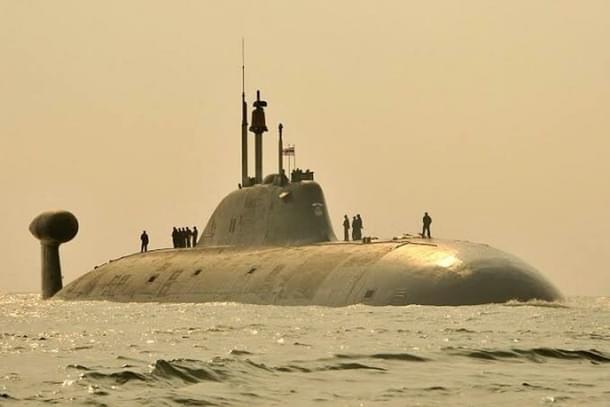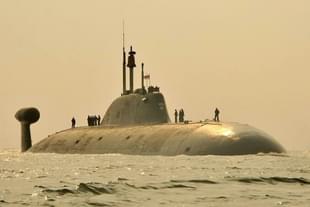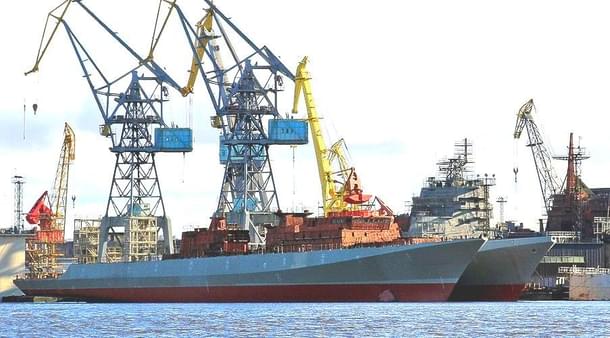Defence
India's Russian Frigates To Set Sail, But S-400s And Nuclear Attack Submarine Drift In Delay
Prakhar Gupta
Nov 11, 2024, 11:52 AM | Updated 11:58 AM IST
Save & read from anywhere!
Bookmark stories for easy access on any device or the Swarajya app.


India is on track to receive the first of its two new guided-missile frigates from Russia, ending a long wait complicated by the ongoing Russia-Ukraine conflict.
Set for delivery at the end of this month, this nearly 4,000-tonne frigate will soon be in the hands of over 200 Indian officers and sailors stationed at the Yantar Shipyard in Kaliningrad, Russia, for months now.
Once handed over, it will be commissioned as INS Tushil and make the journey to Indian waters. Its sister ship, INS Tamal, will follow early next year.
In 2018, India and Russia signed a $500 million contract for the construction of two stealth frigates at Goa Shipyard. An additional deal, valued at nearly $1 billion, was signed later for the import of two other frigates built in Russia.
Both agreements are part of a 2016 deal New Delhi reached with Moscow to procure four Admiral Grigorovich-class frigates.
The other two frigates in the deal are being built at Goa Shipyard, with the first, named Triput, launched in July this year.
The Grigorovich-class frigates, known as Project 11356, have already proven their capability, with three currently in service in Russia's Black Sea Fleet. Russia initially planned six of these frigates under 2010 and 2011 contracts, with the keel for the first ship, Admiral Grigorovich, laid in December 2010 and launched in March 2014. Two additional ships followed by 2015.
However, the remaining three ships were left incomplete at the Yantar Shipyard in Kaliningrad due to a critical issue: the lack of propulsion systems.
The Grigorovich-class frigates, along with other Russian Navy surface vessels, are powered by M90FR (or M7N.1E) gas turbines. These engines were produced by Zorya-Mashproekt, the Soviet Union’s primary gas turbine manufacturing complex, established during the Second World War. Following the Soviet Union's breakup in 1991, this complex came under Ukraine's control, with Russia dependent on supplies from Kyiv.
Russia’s access to these engines ended after its relations with Ukraine deteriorated, beginning with the political crisis in 2013 and culminating in Moscow's annexation of Crimea in 2014, and the invasion of Ukraine in 2022.
In response, Ukraine banned the supply of gas turbines and other critical equipment to Russia. Before the ban, Russia had acquired only three M90FR gas turbines, which were installed on the first three Grigorovich-class frigates.
As a result, the remaining frigates, left without engines, stayed in dry dock.

This is where India’s involvement became pivotal.
In 2016, Ukraine agreed to supply India with M90FR gas turbines in the form of 12 "spare tool and accessory kits." This arrangement enabled India to procure two of the incomplete Grigorovich-class frigates, whose hulls had already been fabricated at the Yantar Shipyard.
India’s familiarity with Ukrainian engines was also a factor; according to Ukraine’s state-owned arms export agency, Ukroboronprom, around 30 Indian Navy ships are already equipped with engines produced by Zorya-Mashproekt.
The arrangement was that Ukraine would sell the kits to India, which would then pass them on to Russia to fit onto the stalled frigates.
India’s decision to proceed with this purchase makes strategic sense, as the Indian Navy already operates six Talwar-class frigates, which Russia built in two batches between 2003 and 2013. The 3,620-ton Admiral Grigorovich-class is an upgraded variant of the Talwar-class, and the addition of these four new Grigorovich-class frigates will bring India’s fleet of Krivak-class-derived ships to a total of ten.
These frigates will be commissioned between 2022 and 2027, around the same time as the delivery of the P17A frigates currently under construction at Mazagon Dockyard and Garden Reach Shipbuilders & Engineers.
The first of the P17A frigates, INS Nilgiri, is undergoing sea trials and is slated for commissioning in December.
However, The delivery of the fourth and fifth squadrons of S-400 surface-to-air missile systems, under the $5.43 billion (Rs 40,000 crore) contract signed with Russia in 2018, is expected only by 2026. India has asked Russia for faster delivery, but it looks difficult because Russia’s entire defence-industrial production is geared toward the Ukraine war.
The IAF has deployed the first three S-400 squadrons — capable of detecting and destroying hostile bombers, jets, spy planes, missiles, and drones within a 380 km range — in northwest and east India to counter both China and Pakistan.
Similarly, the status of the nuclear-powered attack submarine (SSN) that India leased from Russia under a $3 billion agreement signed in 2019 remains uncertain.
The submarine, leased for a period of 10 years, is unlikely to arrive before 2028.
India has previously operated two SSNs leased from Russia. The first, INS Chakra, was a Charlie-class nuclear-powered cruise missile submarine, which served in the Indian Navy from 1988 to 1991.
The second, also named Chakra, was an 8,140-tonne Project 971 (Akula-class) nuclear-powered attack submarine. Its construction began in Russia in 1993 but was halted due to funding shortages. India sponsored the remaining construction and sea trials, with the condition that the submarine be leased to the Indian Navy for a decade. Commissioned as INS Chakra in 2012, the submarine was returned to Russia in June 2021 after an accident, before the lease period concluded.
Amid uncertainty over the third SSN leased from Russia, the Cabinet Committee on Security has cleared the indigenous project to build two SSNs for Rs 40,000 crore, but it will take at least a decade for the first of these to roll out.
Prakhar Gupta is a senior editor at Swarajya. He tweets @prakharkgupta.





